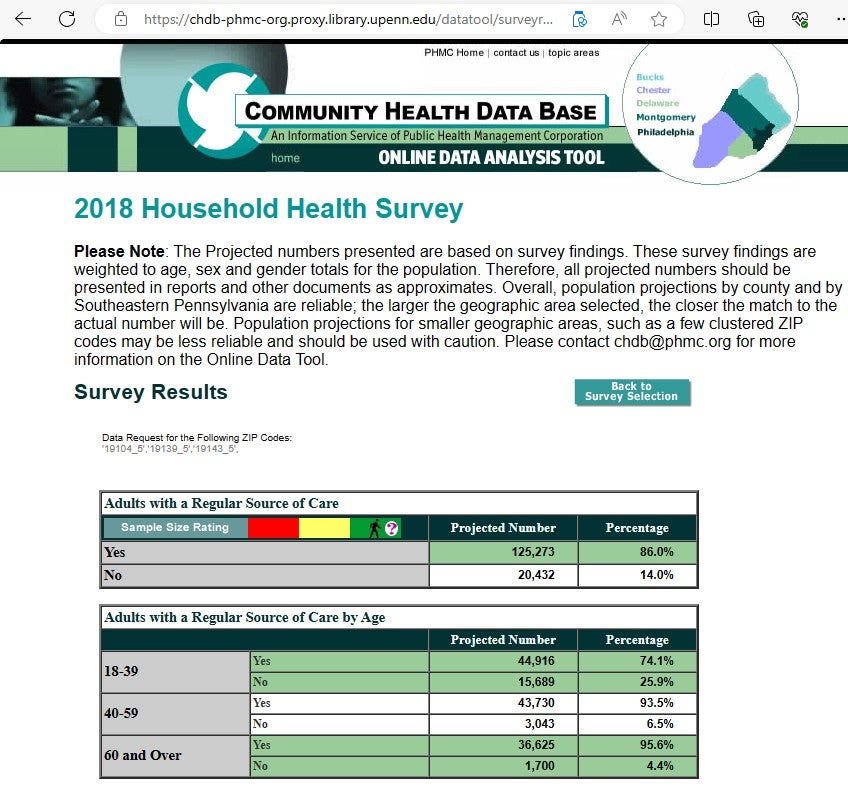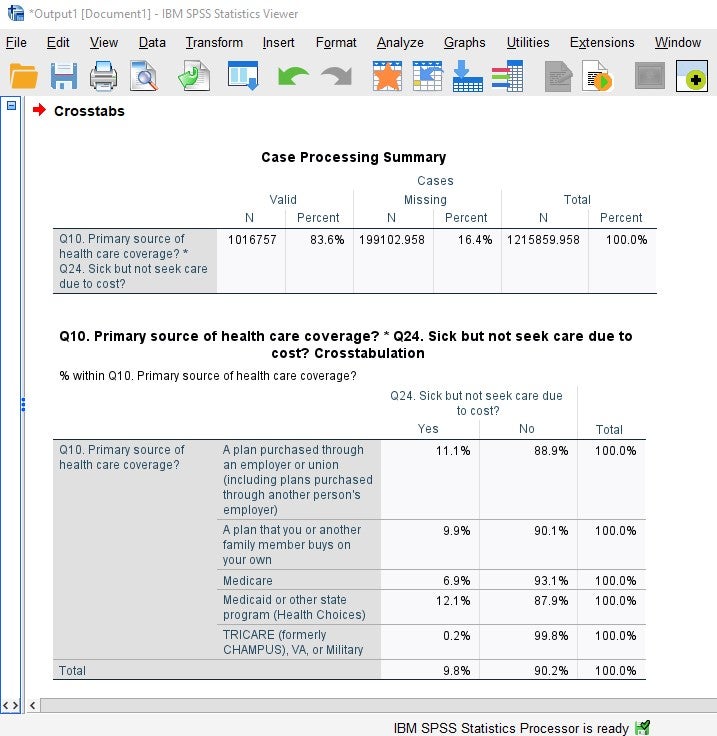The Community Health Data Base: Philadelphia health surveys available via analysis tool and microdata files
The Penn Libraries offers access to the Community Health Data Base, which comprises decades' worth of survey results on health attitudes, practices, and conditions in the Delaware Valley.

From 1983 to 2019, the Community Health Data Base's Southeastern Pennsylvania Household Health Survey collected information on health attitudes, health practices, and health conditions in the Delaware Valley. This telephone survey program, conducted every two or three years by the Public Health Management Corporation, was the earliest, longest running, and among the largest U.S. metropolitan household health surveys of its kind.
The most recent Southeastern Pennsylvania (SEPA) Household Health Survey (HHS) was conducted in 2018-2019, and the survey has since been placed on indefinite hold due to funding constraints. In the meantime, the Penn Libraries offers the datasets, questionnaires, and findings of the Community Health Data Base (CHDB) as a resource providing valuable insights into health attitudes, practices, and conditions over the years in this region.

Background, populations, and scope
The SEPA HHS started as the Philadelphia Household Survey, a program of the Neighborhood-Oriented Health Care Database Project created by what was then called the Philadelphia Health Management Corporation. Findings for this early version of the HHS were published in two 12-volume report series, Neighborhood Health Profiles (Philadelphia Health Management Corporation, 1985 and 1994). The CHDB alternated between this survey and the Philadelphia Older Adult Household Health Survey until 1991, when HHS absorbed the older adult survey with an additional oversample.
For the 1994 wave, the survey program was expanded to include Philadelphia's four surrounding Pennsylvania counties: Bucks, Montgomery, Delaware, and Chester. At the same time, the parent project was renamed the Community Health Data Base. In each wave, the SEPA HHS surveyed approximately 10,000 households across these five counties, with roughly half of respondents being Philadelphia residents.
The SEPA HHS questionnaire was developed in partnership with CHDB members and affiliate organizations. It also re-used and adapted questions from longstanding health survey programs; the Philadelphia Corporation on Aging also assisted in the development of the older adults module. SEPA HHS interviews were conducted in English and Spanish.
In 2008, the SEPA HHS piloted cell phone interviews, with 3% of interviewees using this new method; by 2018 the percentage of interviewees participating by cell phone had jumped to 31 percent. The expansion in cell phone interviewing gave the CHDB increased access to younger adults and to minority populations.
The Community Health Data Base 2018 Multi-Year Data Guide provides an overview of questions from the most recent 11 waves of the HHS, 1996 through 2018. Across all three survey populations — adult, child, and older adult — each wave asked approximately 300 questions. In every wave, questions were asked about chronic conditions, health screenings, and vaccinations; dental care and practices; exercise and nutrition; interaction with health care providers and experiences with health care received; mental health; risk and substance abuse, health insurance, and social capital.
Two SEPA HHS subject modules, Social Environment and Social Capital, both started in 2002. Social environment questions focused on neighborhood belonging and relationships, resident safety, and work travel. Questions around social capital involved respondents’ history in their neighborhood, serious problems in the area, and involvement in volunteer activities.
Special topics – for example, firearm possession and access, drinking sugary beverages, and smoking habits – were explored in one or a few waves.
The SEPA HHS was discontinued after the 2018 wave. Survey data collection is expensive, fewer people cooperate with surveyors, and the widespread replacement of landline phones with mobile phones makes geographically-based surveying difficult. After many years of grant support, the CHDB was not able to fund a 2020-2021 wave. By losing the 2020-2021 survey wave, we have no detailed information on the local persistence of Affordable Care Act health insurance reforms and on Philadelphians' attitudes and responses to the COVID-19 pandemic and shutdown.
Research opportunities and tools
The Penn Libraries offers two electronic data sources for searching SEPA HHS findings: the CHDB Online Data Analysis Tool and the questionnaire-level datasets for each survey. The CHDB Online Data Analysis Tool provides aggregated data tables for ZIP codes covering the 2000-2018 waves. Topics presented in these tables include health status, health behaviors, access and barriers to healthcare, health screens, and community and economy. The tool offers cross-tabulations that break out these tables by age, gender, race/ethnicity, poverty status, insurance status, and religion. As ZIP codes are small areas and the HHS coverage may be uneven across ZIP codes, the tool uses a racetrack graphic to rate the strength of the selected ZIP codes' sample size. The CHDB Online Data Analysis Tool also includes a similar tool for the 2012 Berks Household Health Survey and a tool that ranks selected ZIP codes in comparison to the SEPA region for the 2006 through 2012 SEPA HHS waves.

We also offer the principal data source for the SEPA HHS and the other regional CHDB household health surveys in all available waves (including those for Centre, Berks, Lancaster, and Schuylkill Counties) as microdata files. These are questionnaire-level datasets that present individual responses to questions asked in each wave along with demographic variables. Where the CHDB Online Data Analysis Tool provides a table about high blood pressure for men and women, the microdata user may generate a table showing high blood pressure and environmental conditions or specific health behaviors. Each wave's microdata are SEPA rated into adult, child, and older adult datasets, with an additional combination dataset for all respondent groups. The microdata datasets include variables for several geographies, including census tract and ZIP code that are useful for integrating with contextual Decennial Census and American Community Survey data, Philadelphia neighborhoods, health districts, and planning analysis districts, and suburban planning regions. The microdata datasets also provide weighting variables to adjust for sampling bias when balancing responses within the dataset or for projecting up to an area's total population. The datasets require statistical software as they are offered in SPSS format.
Since 2006, 68 scholarly articles and book chapters have been published by Penn authors using CHDB datasets, questionnaires, and findings, with 52 articles appearing after our initial SEPA HHS microdata acquisition. Six Penn doctoral dissertations have also used CHDB resources. Many Penn schools, departments, and centers are represented in these publications. Recent articles have examined a range of topics, including neighborhood characteristics contributing to psychological symptom severity, greenspace and body mass index, patient navigation systems for breast cancer screening of uninsured minority women, doctor-patient interactions, daily activities of youths and situational triggers of gunshot assault, and smoking cessation and anti-smoking messaging.
Date
July 24, 2024
